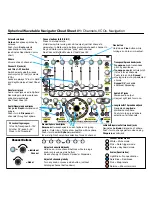
29
Editing Arpeggios
1 .
Press the [ARPEGGIO] button to make it light.
The ARPEGGIO screen appears.
2 .
Move the cursor to the item that you want to edit, and use the value dial to edit the setting.
3 .
Press the [EXIT] button to exit the ARPEGGIO screen.
Parameter
Value/Explanation
STYLE
Selects the arpeggio’s basic performance style.
001–128
Part
In performance mode, this selects the part (only one part) that will be
played by the arpeggio. If a drum kit is assigned to a part, you can play a
drum kit along with the arpeggios.
*
This parameter is not shown if the patch mode is selected or the [SUPER
LAYER] button is on.
Part1 (Upper), Part2 (Lower), Part3–16
Arp Hold
You can produce arpeggios even without continuing to press the
keyboard.
OFF, ON
Grid
Sets the particular note division and resolution in a “single grid” used in
creating the arpeggio in an Arpeggio Style, and how much of a “shuffle”
syncopation is to be to applied (none/weak/strong) to it (grid type).
*
Grid settings are shared with the rhythm pattern.
1/4 (
¸
)
Quarter note (one grid section = one beat)
1/8 (
˙
)
Eighth note (two grid sections = one beat)
1/8 (
˙
) L
Eighth note shuffle Light (two grid sections = one beat, with a
light shuffle)
1/8 (
˙
) H
Eighth note shuffle Heavy (two grid sections = one beat, with
a heavy shuffle)
1/12 (
¯
)
Eighth note triplet (three grid sections = one beat)
1/16 (
˜
)
Sixteenth note (four grid sections = one beat)
1/16 (
˜
) L Sixteenth note shuffle Light (four grid sections = one beat,
with a light shuffle)
1/16 (
˜
) H Sixteenth note shuffle Heavy (four grid sections = one beat,
with a heavy shuffle)
1/24 (
´
)
Sixteenth note triplet (six grid sections = one beat)
Duration
This determines whether the sounds are played staccato (short and
clipped), or tenuto (fully drawn out).
*
Duration settings are shared with the rhythm pattern.
30–120%
For example, when set to “30%,” the length of the note in a
grid (or when a series of grids is connected with ties, the final
grid) is 30% of the full length of the note set in the grid type.
Full
Even if the linked grid is not connected with a tie, the same
note continues to sound until the point at which the next new
sound is specified.
Motif
Refer to “Selecting Ascending/Descending Variations (Motif)” (p. 29).
Velocity
Specifies the loudness of the notes that you play.
REAL
The velocity will change according to how strongly you strike
the key.
1–127
The notes will be sounded with the velocity you specify here,
regardless of how strongly you strike the key.
Oct Range
Adds an effect that shifts arpeggios one cycle at a time in octave units
(octave range). You can set the shift range upwards or downwards (up to
three octaves up or down).
-3–+3
Accent
Adjust the amount (“spread”) of this dynamic variation.
With a setting of “100,” the arpeggiated notes will have the velocities that
are programmed by the arpeggio style. With a setting of “0,” all arpeggiated
notes will be sounded at a fixed velocity.
0–100
Selecting Ascending/Descending Variations (Motif)
Selects the method used to play sounds (motif) when you have a greater number of
notes than programmed for the Arpeggio Style.
*
When the number of keys played is less than the number of notes in the Style,
the highest-pitched of the pressed keys is played by default.
Value
Explanation
Up (L)
Only the lowest of the keys pressed is sounded each time, and the notes play in
order from the lowest of the pressed keys.
Up (L&H)
Notes from both the lowest and highest pressed keys are sounded each time,
and the notes play in order from the lowest of the pressed keys.
Up (_)
The notes play in order from the lowest of the pressed keys.
No note is played every time.
Down (L)
Only the lowest of the keys pressed is sounded each time, and the notes play in
order from the highest of the pressed keys.
Down (L&H)
Notes from both the lowest and highest pressed keys are sounded each time,
and the notes play in order from the highest of the pressed keys.
Down (_)
The notes play in order from the highest of the pressed keys.
No note is played every time.
U/D (L)
Notes will be sounded from the lowest to the highest key you press and then
back down to the lowest key, with only the lowest key sounded each time.
U/D (L&H)
Notes from both the lowest and highest pressed keys are sounded each time,
and the notes play in order from the lowest of the pressed keys and then back
again in the reverse order.
U/D (_)
The notes play in order from the lowest of the pressed keys, and then back
again in the reverse order. No note is played every time.
Rand (L)
Notes will be sounded randomly for the keys you press, with only the lowest
key sounded each time.
Rand (_)
Only the lowest of the keys pressed is sounded each time, the notes you press
will be sounded randomly. No note is played every time.
Phrase
Pressing just one key will play a phrase based on the pitch of that key. If you
press more than one key, the key you press last will be used.










































